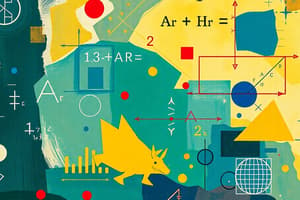Podcast
Questions and Answers
What does the acronym PEMDAS represent in the order of operations?
What does the acronym PEMDAS represent in the order of operations?
- Parentheses, Exponents, Multiplication, Division, Addition, Subtraction (correct)
- Parentheses, Exponents, Division, Multiplication, Addition, Subtraction
- Parentheses, Exponents, Addition, Subtraction, Multiplication, Division
- Parentheses, Exponents, Addition, Division, Multiplication, Subtraction
Which formula correctly calculates the area of a rectangle?
Which formula correctly calculates the area of a rectangle?
- Length / Width
- Length x Width (correct)
- Length + Width
- 2(Length + Width)
In algebra, what is the slope-intercept form of a linear equation?
In algebra, what is the slope-intercept form of a linear equation?
- y = m(x - x1) + y1
- y = ax^2 + bx + c
- y = mx + b (correct)
- y - y1 = m(x - x1)
Which of the following functions is not a trigonometric function?
Which of the following functions is not a trigonometric function?
What is the equation of the Pythagorean theorem?
What is the equation of the Pythagorean theorem?
What is the greatest common divisor (GCD) of 12 and 15?
What is the greatest common divisor (GCD) of 12 and 15?
What does the term 'normal distribution' refer to in statistics?
What does the term 'normal distribution' refer to in statistics?
Which of the following is an example of an irrational number?
Which of the following is an example of an irrational number?
Which operation is not typically associated with sets in set theory?
Which operation is not typically associated with sets in set theory?
Flashcards are hidden until you start studying
Study Notes
Basic Concepts of Mathematics
-
Arithmetic
- Addition, subtraction, multiplication, division
- Order of operations (PEMDAS: Parentheses, Exponents, Multiplication and Division, Addition and Subtraction)
-
Algebra
- Variables and expressions
- Solving equations and inequalities
- Functions and their properties
- Linear equations (slope-intercept form, standard form)
-
Geometry
- Points, lines, angles, shapes
- Perimeter, area, volume formulas for common shapes
- Theorems (e.g., Pythagorean theorem, properties of triangles)
-
Trigonometry
- Sine, cosine, tangent functions
- Unit circle and right triangle relationships
- Trigonometric identities (e.g., Pythagorean identity)
-
Calculus
- Limits and continuity
- Derivatives and their applications
- Integrals and accumulation functions
- Fundamental theorem of calculus
-
Statistics
- Descriptive statistics (mean, median, mode)
- Probability concepts (independent and dependent events)
- Distributions (normal, binomial, etc.)
- Inferential statistics (hypothesis testing, confidence intervals)
-
Number Theory
- Prime numbers, factors, multiples
- Greatest common divisor (GCD) and least common multiple (LCM)
- Modular arithmetic
-
Set Theory
- Sets, subsets, unions, intersections
- Venn diagrams and their applications
Useful Techniques
-
Problem Solving
- Break down complex problems into manageable parts
- Look for patterns and use logical reasoning
- Check solutions by plugging back into the original problem
-
Visualization
- Use graphs and charts to represent data and relationships
- Draw diagrams for geometric problems
-
Estimation
- Round numbers to simplify calculations
- Use estimation to quickly check the reasonableness of answers
-
Units of Measurement
- Common units (length, area, volume, weight)
- Conversion factors between different units
Key Mathematical Fun Facts
- Mathematics is universal and transcends language.
- The Fibonacci sequence appears in various natural phenomena.
- Zero is both a number and a concept, representing the absence of quantity.
- Pi (π) is an irrational number representing the ratio of a circle's circumference to its diameter.
Basic Concepts of Mathematics
- Arithmetic involves the fundamental operations of addition, subtraction, multiplication, and division. Determining the order of operations (PEMDAS: Parentheses, Exponents, Multiplication and Division, Addition and Subtraction) is critical for accurate calculations.
- Algebra introduces variables and expressions, allowing for the representation and manipulation of unknown quantities. Key aspects include solving equations and inequalities, understanding functions and their properties, and working with linear equations.
- Geometry examines points, lines, angles, and shapes, focusing on properties and relationships. Essential concepts include calculating perimeter, area, and volume for common shapes, and applying theorems such as the Pythagorean theorem.
- Trigonometry deals with trigonometric functions, specifically sine, cosine, and tangent. It utilizes the unit circle and right triangle relationships to solve problems involving angles and sides.
- Calculus centers around limits, continuity, derivatives, and integrals. It provides tools for understanding rates of change, accumulation, and optimization. The fundamental theorem of calculus establishes a crucial relationship between differentiation and integration.
- Statistics provides methods for analyzing and interpreting data. It encompasses descriptive statistics (mean, median, mode), probability concepts, distributions, and inferential statistics (hypothesis testing, confidence intervals).
- Number Theory focuses on properties of numbers, including prime numbers, factors, multiples, and their relationships. Concepts like the greatest common divisor (GCD) and least common multiple (LCM) are essential.
- Set Theory deals with sets, subsets, unions, intersections, and their relationships. Venn diagrams are useful tools for visualizing set operations.
Useful Techniques
- Problem-solving strategies include breaking down complex problems, identifying patterns, and using logical reasoning. Solutions should be checked against the original problem for accuracy.
- Visualization aids comprehension by using graphs, charts, and diagrams to represent data and relationships.
- Estimation simplifies calculations and helps verify the reasonableness of answers by rounding numbers.
- Units of measurement are crucial for understanding and comparing quantities. Familiarity with common units (length, area, volume, weight) and conversion factors between different units is essential.
Key Mathematical Fun Facts
- Mathematics transcends language, making it universally applicable across cultures.
- The Fibonacci sequence is a fascinating pattern found in nature, like the arrangement of leaves on a stem or the spiral pattern of seashells.
- Zero represents the absence of quantity, serving as a foundational element in number systems.
- Pi (π) is an irrational number representing the ratio of a circle's circumference to its diameter, a constant crucial for calculations involving circles.
Studying That Suits You
Use AI to generate personalized quizzes and flashcards to suit your learning preferences.




